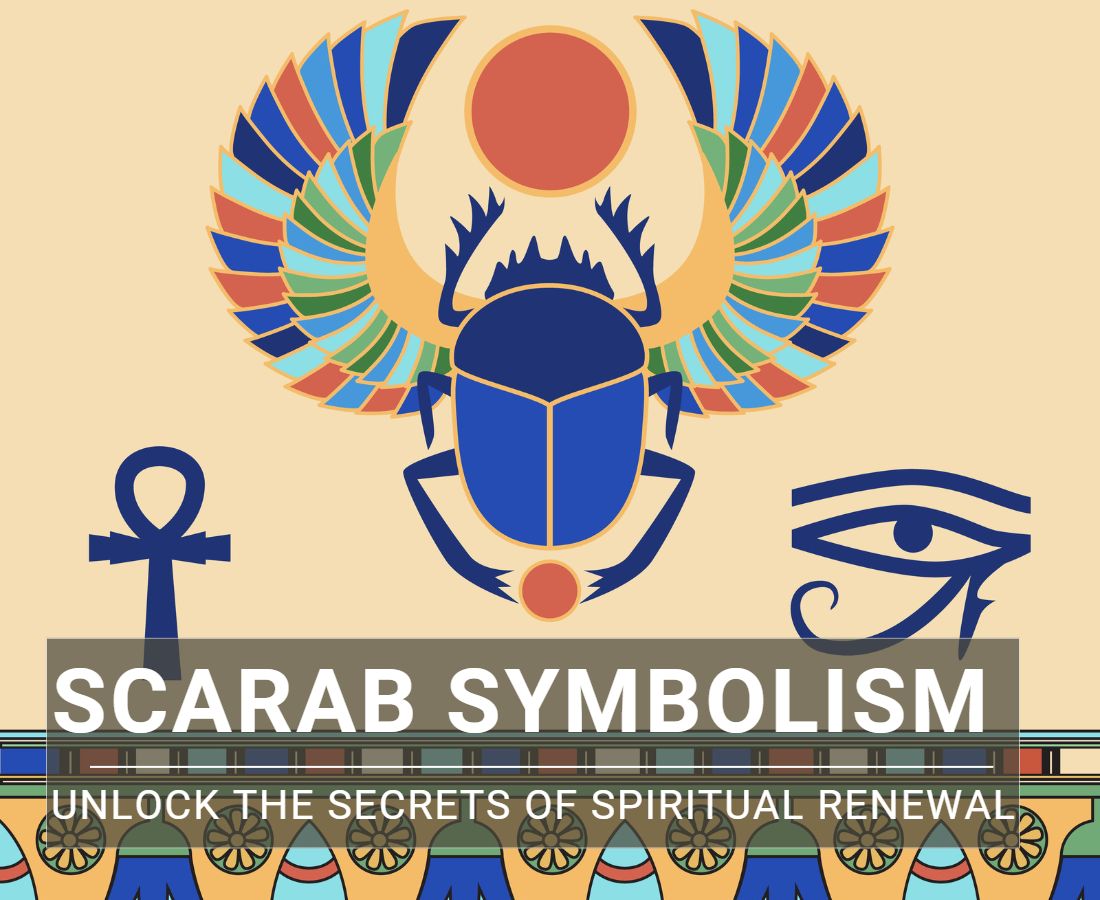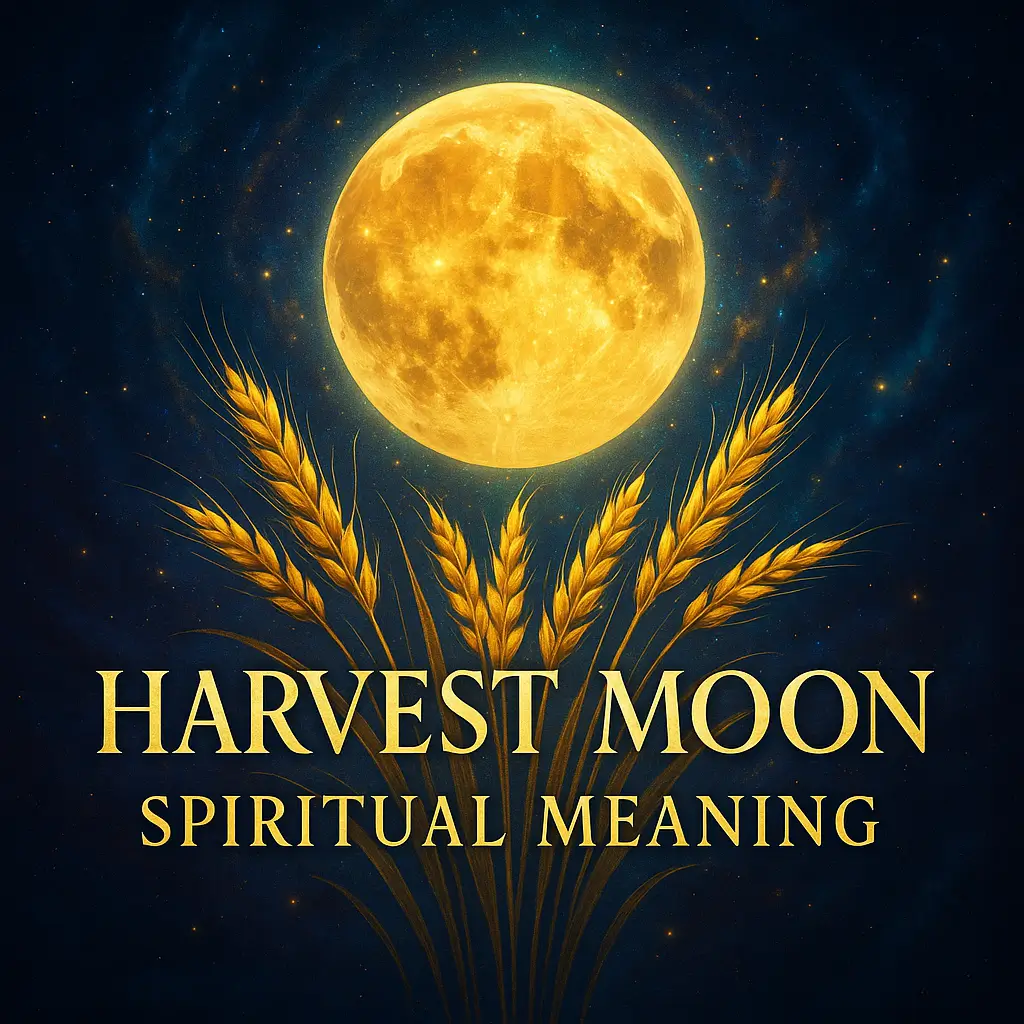The scarab beetle represents one of the world’s oldest symbols, with origins dating back thousands of years to ancient Egypt. If you have watched The Mummy film, you will be more than familiar with the iconic scarab beetle and its powerful ties to the culture and religion of Egypt.
These insects are a type of dung beetle and have been revered and worshiped for their unique characteristics, inspiring symbolic associations toward spiritual truths that can provide powerful insight and life lessons. In this article, we will discuss the spiritual truths and symbolism of the scarab beetle and how it can benefit your life.
Table of Contents
- 1 Key Takeaways
- 2 Spiritual symbolism
- 3 Scarab Beetle Symbolism in Ancient Egypt
- 4 Scarab Beetle Symbolism in Various Cultures
- 5 The Scarab Beetle Spirit Animal
- 6 The Sacred Scarab: Egyptian Amulets and Worldwide Symbolism
- 7 Conclusion
- 8 FAQ
- 8.1 Is a scarab beetle good luck?
- 8.2 Are scarabs mentioned in the Bible?
- 8.3 Are scarabs sacred?
- 8.4 What does it mean if you see a scarab beetle?
- 8.5 What does the Egyptian scarab tattoo mean?
- 8.6 What did the scarab beetle symbolize in ancient Egypt?
- 8.7 Why did Egyptians create scarab amulets?
- 8.8 What is a heart scarab?
- 8.9 What materials were used to make scarab amulets?
- 8.10 What does a scarab beetle tattoo symbolize today?
- 8.11 How did the scarab symbolism spread to other cultures?
- 8.12 What is the connection between scarab beetles and the afterlife?
Key Takeaways
- The scarab beetle is one of ancient Egypt’s most sacred symbols, representing transformation and rebirth associated with gods Khepri and Ra.
- Egyptians used scarab amulets and jewelry for protection and good fortune, believing these beetles possessed magical powers that could attract prosperity.
- The beetle’s life cycle symbolizes fertility and renewal, as it lays eggs in dung balls, providing a powerful metaphor for nurturing creative ideas and projects.
- Across different cultures from Europe to Asia, the scarab has been adopted as a powerful spiritual symbol, though with varying meanings ranging from luck to balance.
- As a spirit animal, the scarab beetle encourages us to embrace change and transformation, letting go of our old selves and putting faith in new beginnings.
Spiritual symbolism
The scarab symbolism can represent many spiritual truths, with the most significant being transformation, protection, luck, and fertility.
Transformation
Scarabs represented transformation in ancient Egypt and were discovered in many tombs to act as guardians to protect pharaohs on their journey through the afterlife. Seeing pharaohs in your daily life can represent a need for transformation in either your relationships, career, or environment.
The transformation of an egg into a larva, then a pupa, and finally an adult beetle mirrors our journey of growth and change. It reminds us that even in the darkest of times, we can emerge stronger and more beautiful than ever.
Scarab beetles were revered in ancient Egypt and associated with the god Khepri, who symbolized the rising sun and the renewal of life. The scarab beetle can remind us to embrace change and transformation in our lives, as well as to see the opportunities for growth that come with new beginnings.
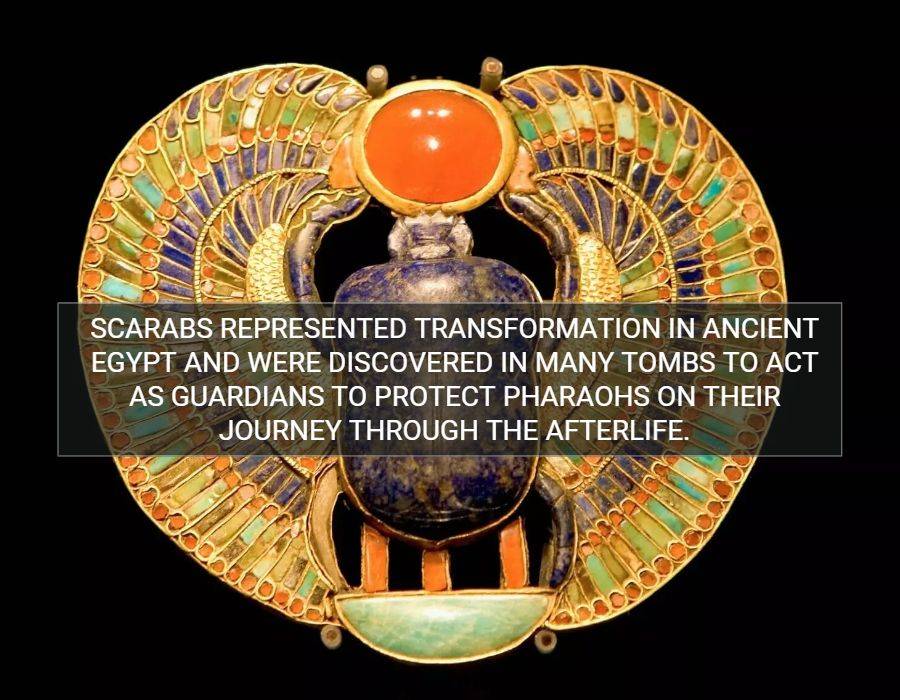
Protection
In many ancient texts and art, scarabs were sometimes depicted with wings outstretched which represented both protection and freedom. They would provide travelers with protection who were navigating dangerous terrain while also granting them free movement in any direction. The duality of the scarabs’ symbolism offers guidance for those seeking strength during challenging times.
Scarab symbolism has been used for thousands of years as amulets and talismans for protection and good fortune. This can serve as a reminder of the power of intention and the importance of surrounding ourselves with positive energy. The spiritual lesson is to focus on what we want to manifest in our lives rather than what we don’t want and to take steps to align our actions with our intentions.
Meditation, with the addition of a winged scarab, can help guide and protect you through your practice from any negative thoughts or energies.
Fertility
Scarab beetles are widely known to roll dung into a sphere where they ultimately lay their eggs to have warmth, food, and protection as they develop. The life cycle of these beetles has long fascinated civilizations who have used their metamorphosis from egg to winged adult to symbolize fertility and new beginnings.
The scarab’s symbolic association with fertility can serve as a reminder to not only value but nurture and care for our creative ideas or projects. It is essential to recognize the fertility of our minds and spirits as we journey through life.
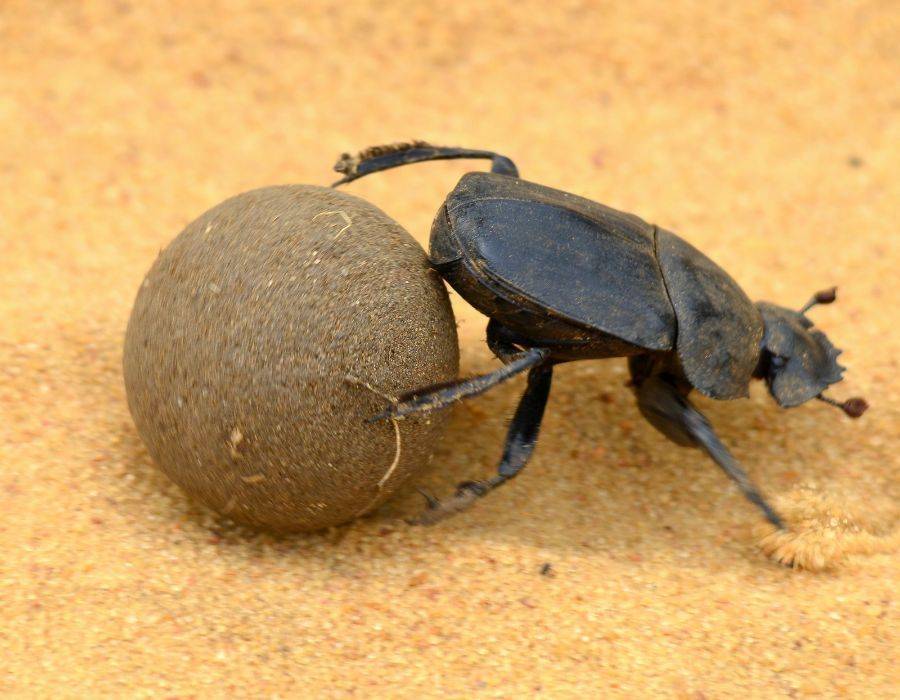
Resurrection
The scarab beetle represented rebirth and eternity in ancient Egyptian mythology and was closely linked to Ra, the sun deity. It symbolized resurrection since it was said to roll the sun across the sky like a scarab rolling its dung ball. Ra was also believed to die and be reborn each day, further reinforcing the symbolism of rebirth and resurrection.
Luck
In many cultures, scarab beetles are associated with good luck and prosperity due in part to their iridescent shells that glimmer in the sunlight. They were considered to possess magical powers or properties that worked to attract positivity and good fortune.
For the Egyptians, individuals wanting success and money, even the Pharaohs themselves, wore scarab amulets.
The scarab beetle serves as a reminder to stay optimistic even in difficult times, trusting that everything will work out in the end. The spiritual lesson is instead of dwelling on the negative, we should cultivate an attitude of gratitude and look for the blessings in our lives.
Practicing positive affirmations and thoughts can significantly increase luck or abundant energy in your daily life.
Head on over to YouTube to learn more about these amazing beetles!
Scarab Beetle Symbolism in Ancient Egypt
Throughout Egyptian history, scarab beetles have been associated with various gods, including Khepri and Ra. The beetle was regarded as a symbol of the rising sun representing rebirth and renewal.
Since the Scarab beetle was an important symbol in ancient Egyptian culture, even scarab hieroglyphs featuring the insect have been discovered in various artifacts and tombs.
God Khepri
Ancient Egyptians believed that Khepri, the god of the rising sun, was often depicted with the body of a man and the head of a scarab. He was known as a god of creation and renewal and was thought to be responsible for the sun’s daily rebirth.
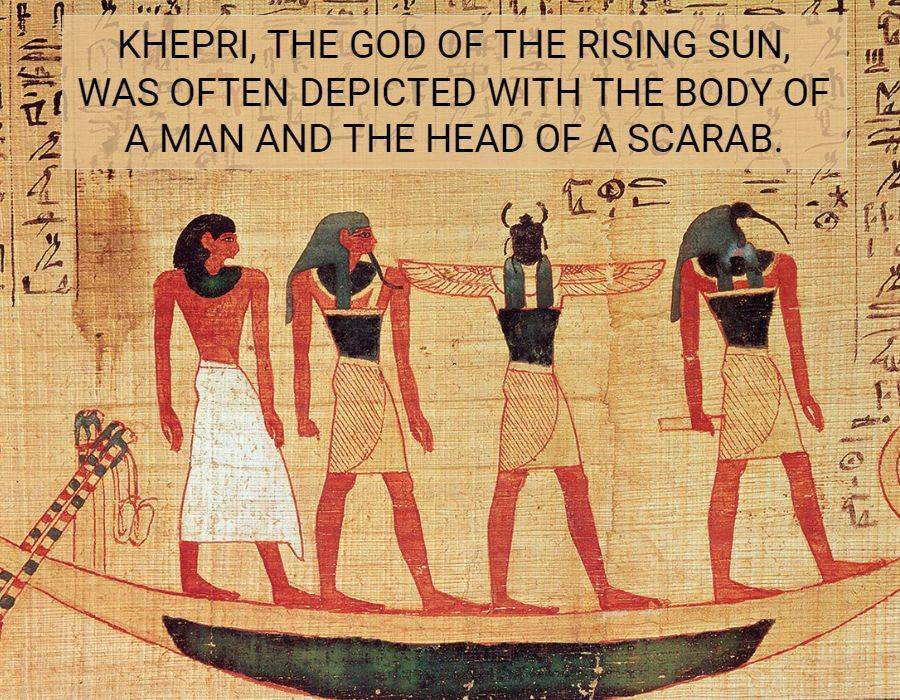
The scarab symbolism was associated with Khepri by the ancient Egyptians because they observed the beetle rolling dung balls across the ground, which they saw as a symbol of the sun rolling across the sky. The ability of the beetle to emerge unscathed from the dung ball was also interpreted as a symbol of regeneration and rebirth.
Sun God Ra
Ra was a major god in ancient Egyptian mythology who was associated with the sun, creation, and power. While Ra was not directly associated with the winged scarab meaning, it was a significant symbol in his mythology.
The scarab beetle was thought to represent the sun by the ancient Egyptians, who saw it as a manifestation of Ra’s power and energy. As a result, the scarab beetle was frequently used as a symbol of Ra’s creative and regenerative abilities.
Worn as Jewelry
Egyptians wore jewelry adorned with scarab beetles since they were an important symbol of creation, renewal, and rebirth, and they were thought to have protective and magical powers.
Scarab jewelry, such as amulets, bracelets, and rings, was thought to be a way to connect with these powers and benefit from the beetle’s protective abilities.
Scarab Beetle Symbolism in Various Cultures
Scarab beetles have appeared throughout history, playing an important role in many different civilizations.
European culture
Ancient Romans and Greeks adopted the sacred scarab of the Egyptians primarily as a good luck charm. They left out the symbolic Egyptian components of life after death and instead developed the meaning of the scarab to the keeper of balance.
Scarab Beetles were found wherever someone could use a bit of extra luck, such as aboard ships and within Roman graves, to accompany them on their journey to the afterlife. There are even a few Greek and Roman coins that bear the symbol of the scarab, which further highlights its significance.
Asian culture
In Asia, the scarab spiritual meaning is typically seen in conjunction with food, medicine, religion, and art primarily due to its abundance and nutritional value. Typically all phases of the scarab beetle’s life cycle are important in Asian culture from egg, larva, or adult.
The scarab beetle was associated with the element of earth and represented fertility and abundance in ancient Chinese culture. The beetle was frequently depicted in art and mythology, and it was also used as a protective and good luck symbol.
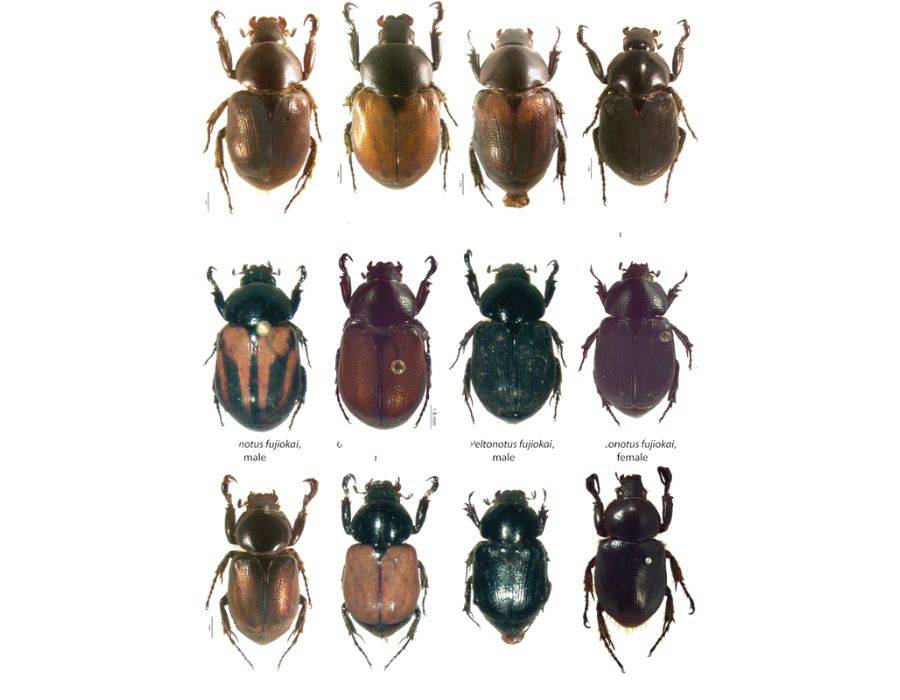
Australian culture
The nomadic Aboriginals of Australia would use the symbol of the scarab beetle displayed as a totem animal to represent their significance. Scarabs were eaten by Aborigines as part of a fertility ceremony as well as a source of food for the Australian natives.
North American Culture
Native American Indians recognized the scarab beetle in their culture but largely rejected them as a source of food or in their ceremony practices and medicine.
The scarab symbolism was frequently used to symbolize the cycle of life and death in Native American culture. The ability of the beetle to emerge from its cocoon or dung ball was interpreted as a symbol of transformation and rebirth, as well as renewal and regeneration.
The Scarab Beetle Spirit Animal
The scarab symbolism has long been seen as a symbol of renewal and change. It inspires us to let go of our old selves, face change head-on, and put our faith in the strength of good fortune protection that each fresh start offers.
This motivating creature points people in the direction of an even brighter future with its strong symbolism for spiritual awakening and personal development!
The Sacred Scarab: Egyptian Amulets and Worldwide Symbolism
The scarab beetle’s significance extends beyond mere symbolism—it has been crafted into powerful amulets and talismans across civilizations for thousands of years. The ancient Egyptians carved scarabaeus beetles from various materials, including faience, stone, and precious metals, creating the iconic Egyptian scarab amulet that served as both religious objects and personal protection charms.
Decoding the Ancient Scarab Hieroglyphics
When learning how to read hieroglyphics, the scarab symbol (representing the sound “kheper”) is one of the most recognizable glyphs. These Egyptian beetle symbols appear in countless inscriptions and serve as a key to understanding ancient texts. Amulets often combined the scarab form with hieroglyphic inscriptions on their flat undersides, creating protective seals that carried specific prayers or blessings for the wearer.
Scarab Beetle Varieties and Their Unique Meanings
While the classic black scarab is most commonly recognized, various colored scarabs carried distinct meanings. The blue scarab meaning connects to the heavens and divine protection, while red scarab beetles symbolized the life-giving power of blood and vitality. The rare and magnificent emerald scarab beetle, with its iridescent shell, was particularly treasured and associated with the highest levels of divine protection. Archaeological discoveries have revealed heart scarabs—special amulets placed over the heart of the deceased during mummification to ensure favorable judgment in the afterlife.
Beyond Egypt, Canaanite scarabs and seals adopted the Egyptian motif but incorporated local deities and practices. These journey beetles, as they were sometimes called, represented safe passage through difficult transitions. The scarab motif in modern scarab jewelry continues this ancient tradition, with scarab bracelets and scarab charms remaining popular symbols of transformation and good fortune. Today, the scarab beetle tattoo has gained popularity as a permanent reminder of personal change and resilience, connecting wearers to this ancient and powerful symbol of perpetual renewal.
Conclusion
The scarab beetle is a powerful symbol that has played an important role throughout history in many different cultures and civilizations. The beetle has been associated with themes of creation, rebirth, and transformation from ancient Egypt to modern times and has been used as a symbol of protection, good luck, and transformation.
The scarab beetle’s powerful symbolism contains profound spiritual truths that can benefit our lives in many ways. We can tap into the power of transformation and regeneration by connecting with the beetle’s protective energy and luck properties. The scarabs energy can help us navigate the challenges and transitions in our lives to find peace and fulfillment.
Also, check our post about beetle symbolism.
FAQ
Is a scarab beetle good luck?
The scarab beetle is an enduring representation of luck, safety, and metamorphosis. It was highly prized in ancient Egypt and was worn as an amulet to bring money and success; Today, the Scarab beetle continues to be associated with luck, making it a popular symbol in many cultures.
Are scarabs mentioned in the Bible?
In Leviticus 11:22, the Bible alludes to a mysterious species of beetle deemed “unclean” by God. While not explicitly stated, many believe this infamous insect could have been none other than the ancient Scarab beetle – an iconic symbol in Ancient Egyptian culture treasured for its beauty and sacred powers.
Are scarabs sacred?
Yes, Scarabs were considered sacred in ancient Egyptian culture. From tombs to temples, these beetles are featured prominently in artworks throughout the ages. Even today scarab motifs grace jewelry pieces; their spiritual symbolism continues to be celebrated around the world.
What does it mean if you see a scarab beetle?
See a Scarab beetle? Consider it your sign! This spirit animal is all about personal growth and transformation – urging us to embrace change instead of running from it. It could be seen as an emblem of good luck, protection, and resilience; encouraging you to trust in yourself and move forward with confidence into the unknown.
What does the Egyptian scarab tattoo mean?
Drawing from the spiritual heritage of Ancient Egypt, many are drawn to a Scarab beetle tattoo for its symbolism. Representing rebirth and renewal, these sacred tattoos provide a reminder of personal growth and protection on one’s journey through life–a potent symbol that evokes luck in times of transformation!
What did the scarab beetle symbolize in ancient Egypt?
In ancient Egypt, the scarab beetle symbolized transformation, rebirth, and creation. Associated with the sun god Ra and his morning manifestation Khepri, the beetle’s habit of rolling dung balls resembled how Egyptians believed the sun was pushed across the sky each day.
Why did Egyptians create scarab amulets?
Egyptians crafted scarab amulets as powerful protective talismans. They believed these objects carried magical properties that could ward off evil, provide protection in the afterlife, and bring good fortune to the wearer during their lifetime.
What is a heart scarab?
A heart scarab was a special funerary amulet placed over the heart of a mummified person. Often inscribed with spells from the Book of the Dead, it prevented the heart from testifying against the deceased during judgment in the afterlife.
What materials were used to make scarab amulets?
Scarab amulets were crafted from various materials including faience (a ceramic material), steatite (soapstone), gemstones like lapis lazuli and carnelian, and precious metals such as gold and silver. The material often enhanced the amulet’s specific magical properties.
What does a scarab beetle tattoo symbolize today?
Modern scarab beetle tattoos symbolize personal transformation, resilience, and new beginnings. They represent the ability to evolve through life’s challenges and emerge renewed, connecting wearers to ancient wisdom while expressing individual journeys of change.
How did the scarab symbolism spread to other cultures?
Scarab symbolism spread through trade routes and cultural exchanges. Phoenicians and Canaanites adopted and adapted Egyptian scarab designs, while Greek and Roman travelers brought these symbols back to Europe, where they evolved to represent various aspects of luck and protection.
What is the connection between scarab beetles and the afterlife?
Egyptians believed scarab beetles ensured safe passage into the afterlife. The beetle’s natural behavior of emerging from the ground symbolized resurrection, while its association with the daily rebirth of the sun represented eternal cycles of life, death, and renewal.
